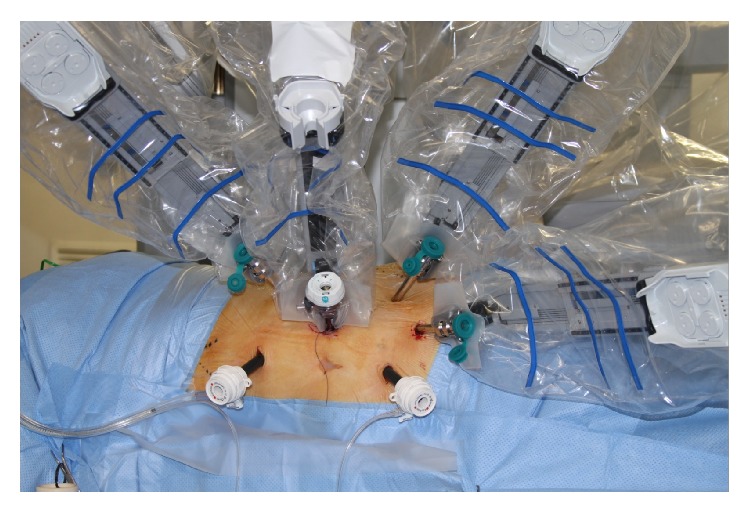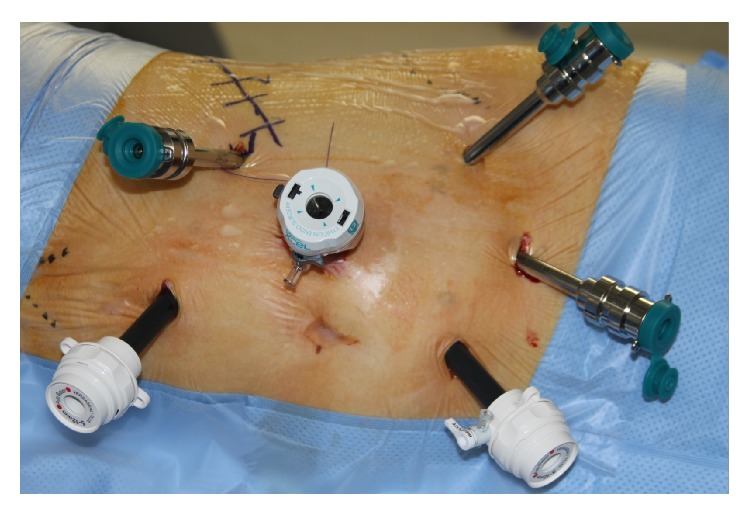{"title":"Early Experience in Da Vinci Robot-Assisted Partial Nephrectomy: An Australian Single Centre Series.","authors":"Francis Ting, Richard Savdie, Sam Chopra, Carlo Yuen, Phillip Brenner","doi":"10.1155/2015/671267","DOIUrl":null,"url":null,"abstract":"<p><p>Introduction and Objectives. To demonstrate the safety and efficacy of the robot-assisted partial nephrectomy (RAPN) technique in an Australian setting. Methods. Between November 2010 and July 2014, a total of 76 patients underwent 77 RAPN procedures using the Da Vinci Surgical System© at our institution. 58 of these procedures were performed primarily by the senior author (PB) and are described in this case series. Results. Median operative time was 4 hours (range 1.5-6) and median warm ischaemic time (WIT) was 8 minutes (range 0-30) including 11 cases with zero ischaemic time. All surgical margins were clear with the exception of one patient who had egress of intravascular microscopic tumour outside the capsule to the point of the resection margin. Complications were identified in 9 patients (15.8%). Major complications included conversion to open surgery due to significant venous bleeding (n = 1), reperfusion injury (n = 1), gluteal compartment syndrome (n = 1), DVT/PE (n = 1), and readmission for haematuria (n = 1). Conclusion. This series demonstrates the safety and efficacy of the RAPN technique in an Australian setting when performed by experienced laparoscopic surgeons in a dedicated high volume robotic centre. </p>","PeriodicalId":45110,"journal":{"name":"Minimally Invasive Surgery","volume":"2015 ","pages":"671267"},"PeriodicalIF":1.3000,"publicationDate":"2015-01-01","publicationTypes":"Journal Article","fieldsOfStudy":null,"isOpenAccess":false,"openAccessPdf":"https://sci-hub-pdf.com/10.1155/2015/671267","citationCount":"2","resultStr":null,"platform":"Semanticscholar","paperid":null,"PeriodicalName":"Minimally Invasive Surgery","FirstCategoryId":"1085","ListUrlMain":"https://doi.org/10.1155/2015/671267","RegionNum":0,"RegionCategory":null,"ArticlePicture":[],"TitleCN":null,"AbstractTextCN":null,"PMCID":null,"EPubDate":"2015/6/8 0:00:00","PubModel":"Epub","JCR":"Q3","JCRName":"SURGERY","Score":null,"Total":0}
引用次数: 2
Abstract
Introduction and Objectives. To demonstrate the safety and efficacy of the robot-assisted partial nephrectomy (RAPN) technique in an Australian setting. Methods. Between November 2010 and July 2014, a total of 76 patients underwent 77 RAPN procedures using the Da Vinci Surgical System© at our institution. 58 of these procedures were performed primarily by the senior author (PB) and are described in this case series. Results. Median operative time was 4 hours (range 1.5-6) and median warm ischaemic time (WIT) was 8 minutes (range 0-30) including 11 cases with zero ischaemic time. All surgical margins were clear with the exception of one patient who had egress of intravascular microscopic tumour outside the capsule to the point of the resection margin. Complications were identified in 9 patients (15.8%). Major complications included conversion to open surgery due to significant venous bleeding (n = 1), reperfusion injury (n = 1), gluteal compartment syndrome (n = 1), DVT/PE (n = 1), and readmission for haematuria (n = 1). Conclusion. This series demonstrates the safety and efficacy of the RAPN technique in an Australian setting when performed by experienced laparoscopic surgeons in a dedicated high volume robotic centre.


达芬奇机器人辅助部分肾切除术的早期经验:澳大利亚单中心系列。
引言和目标。为了证明机器人辅助部分肾切除术(RAPN)技术在澳大利亚的安全性和有效性。方法。2010年11月至2014年7月,共有76名患者在我院使用达芬奇手术系统©进行了77次RAPN手术。其中58例手术主要由资深作者(PB)执行,并在本病例系列中进行了描述。结果。中位手术时间为4小时(1.5 ~ 6),中位热缺血时间(WIT)为8分钟(0 ~ 30),其中11例为零缺血时间。所有的手术边缘都是清晰的,除了一个患者在囊外的血管内显微镜下肿瘤出口到切除边缘点。并发症9例(15.8%)。主要并发症包括因明显静脉出血(n = 1)、再灌注损伤(n = 1)、臀间室综合征(n = 1)、DVT/PE (n = 1)和因血尿再入院(n = 1)而转开手术。这一系列证明RAPN技术的安全性和有效性在澳大利亚设置时,由经验丰富的腹腔镜外科医生在专门的高容量机器人中心进行。
本文章由计算机程序翻译,如有差异,请以英文原文为准。



 求助内容:
求助内容: 应助结果提醒方式:
应助结果提醒方式:


